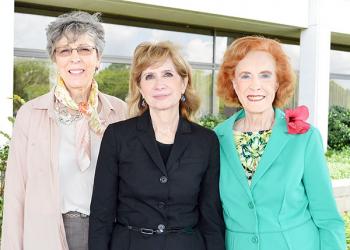
Mary K. Schmidl, center, adjunct professor in food science and nutrition at the University of Minnesota, was guest speaker at the 14th Annual Patrick Lecture on April 19 and 20 in Baton Rouge. With Schmidl are, left, Louise Wicker, director of the LSU AgCenter School of Nutrition and Food Sciences, and Ruth Patrick, retired AgCenter food and nutrition specialist.
Food expert: Eat better, move more
BATON ROUGE — The world has about 6.2 million square miles of cropland, about the size of South America, and 11.6 million acres of pastures, about the size of Africa. And that’s all we’re ever going to have for food production, Mary K. Schmidl told an audience on the LSU campus on April 19.
Schmidl, a researcher and adjunct professor of food science and nutrition at the University of Minnesota, was guest speaker for the 14th annual LSU Patrick Lecture Series.
“We’re using about 40 percent of the earth to feed the world,” she said. “What we’re using today is what we’ll be using 50 years from now.”
What’s left is desert, mountains, tundra and deep rainforest, while urban areas occupy less than one percent of the available land. The challenge is to develop new plant varieties and new ways of raising crops to be able to feed a growing world population.
Schmidl gave an example in golden rice, which was developed with increased beta-carotene, which is a source of vitamin A. Unfortunately, people won’t eat it because it was developed through genetic modification.
“People are going to believe what they want to believe,” she said. “It’s not nutrition if you don’t eat it.”
One answer to equalizing food distribution is to reduce food waste in developed countries. “We have enough food, but it’s not equally available,” she said.
Schmidl’s presentation on Healthy Food, Healthy Planet was the first of two presentations she gave as part of the 2016 Patrick Lecture Series. On April 20, she spoke on Sugars: Science and Politics in the Reilly Auditorium at the Pennington Biomedical Research Center.
Schmidl looked at the history of sugars around the globe and the rise in consumption of sugar dating to the 1800s.
“Sugar was precious and expensive. It was kept under lock and key,” Schmidl said.
The development of extracting sugar from sugar beets and the patent on the sugar cube made sugar more readily available.
In 1902, food scientists hydrolyzed corn to make corn syrup and half a century later in the 1950s, they developed the technique of converting glucose to fructose in high fructose corn syrup.
“In 1984, Coke and Pepsi switched to high fructose corn syrup. This was driven by price, not taste or anything else” Schmidl said, noting that high fructose corn syrup costs about half the price of beet or cane sugar.
Schmidl said American’s daily sugar intake has increased dramatically in the past 70 years. In the mid-1900s consumers took in about 130 calories from sugar. Today it is more than 500 calories.
“Most of the sugar we consume comes from sugar-sweetened beverages,” Schmidl said. “These drinks fail to produce satiety.” Research shows sweetened beverages can encourage individuals to consume more calories.
The overall approach she suggested to controlling obesity isn’t increasing access healthy food, but rather decreasing the availability of unhealthy foods.
“If you give people healthier food options, you hope it will displace unhealthy food and lead to less obesity,” Schmidl said. But she said that is not usually the case, suggesting, for example, that people will choose brownies over carrots.
The message in both of her lectures was to “eat more fruits and vegetables, and get out and move more.”
The Patrick Lecture Series was established by Ruth Patrick and her late husband, Bill Patrick. The endowment fund sponsors a lecture each year that alternates between the fields of human nutrition/food science and wetland sciences/coastal studies — reflecting the professional interests of the donors.
Bill Patrick was director of the LSU Wetland Biogeochemistry Institute, and Ruth Patrick was a food and nutrition specialist with the LSU AgCenter at the time they established the endowment.
- Log in to post comments
